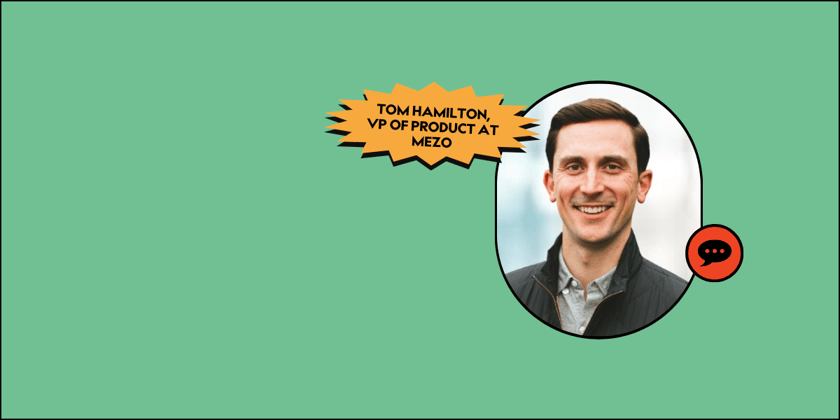Listen to the article
Mastering Product Management in PropTech: Insights from Mezo
Every product needs a roadmap, a value proposition, customer feedback, a feature set, requirements, review periods, prioritization, jobs to be done, pains & gains, beta testing…the list goes on. What does it take to build out product management in PropTech and create something with real value? Something that will go from solving a specific problem to becoming a scaled business model?
We had the opportunity to sit down with Tom Hamilton, the new VP of Product at Mezo, to learn what has given the PropTech startup its early success and to pick up general tips on effective product management.
PlanOmatic: As the VP of Product at Mezo, can you tell us a little bit about Mezo and what your product offering includes?
Tom Hamilton: Mezo is a proptech SaaS solution, focused on making property maintenance easier for everyone involved – we partner with multifamily and single-family rental owners, operators, and property managers.
The property maintenance landscape has remained stagnant for years, lacking the innovation necessary to tackle its inherent inefficiencies be it wasted time, money, or effort. As someone who’s renting, I can vouch for the frustration of dealing with maintenance woes — a sentiment echoed by many renters, as it’s often cited as one of the top three reasons people consider moving.
Historically, technicians’ hands have been tied. Without seeing problems with their own eyes, they have no way to know what’s wrong, how to fix it, and the parts and tools they’ll need. Mezo has found a low-cost, high-accuracy way to bridge the gap in a way that helps residents engage in meaningful ways, including troubleshooting and sometimes even DIY.
But more importantly, the ‘resident coaching’ our platform provides captures critical data that Mezo transforms for dispatchers and technicians to ensure issues are solved on the first trip. Insights we provide include: recommended repair, parts & tools needed, detailed appliance data, skill sets required, resident’s availability, and more.

Photo courtesy of Mezo
Our innovation cuts down work order resolution times by over 30%. While residents are happier with faster resolutions, landlords too reap significant time and financial benefits. Feedback from all stakeholders — be it residents, technicians, or landlords — suggests that Mezo offers a win, win, win for each user.
And the cherry on top for landlords and owners is the ROI. The product pays for itself just from the resident coaching to troubleshoot and mitigate damages, and that’s not even accounting for the saved labor costs and enhanced tenant satisfaction that comes from efficient resolutions.
PlanOmatic: How is your product roadmap created to ensure stakeholder input is accounted for while managing expectations?
Tom Hamilton: Let me start by sharing that I grew up sailing with my dad so will leverage a sailing analogy to keep it fun.
Imagine a sailboat journeying across a big body of water. The vision for our product is akin to the distant shore. It’s our guiding star, the ultimate destination that gives purpose to our trip.
Our product roadmap is the course we chart to get there. Just as a sailor plots a course on a map, our team lays out our intentions for the product over the next 6-12 months. But, just as sailors deal with shifting winds and unpredictable obstacles, we recognize that our plans may require change based on the market, tech advancements, or more often than not feedback from users.
The immediate 3-6 months of our roadmap are like the waters right around our boat: clear and immediate, with our actions being definite and specific. As we look further out, towards the 6-12 month horizon, our plans resemble the distant waters: they’re more open to course adjustments, always with an eye on the prevailing conditions.
In essence, while our vision remains steady like the distant shore, our roadmap, much like the course of a sailboat, is designed to be adaptable, ensuring we navigate our journey effectively and reach our desired destination.
As for how we manage expectations, the vision and roadmap work in tandem to ensure everyone is aligned on our trip. If teams can’t agree on where we are sailing, it’ll be harder to decide the near-term direction. Equally important, the ‘crew’ (i.e., our team) needs clarity to execute on our path together. We need details on what added value each feature request is providing, and we have to be realistic with when each request can be completed.
All in all, the roadmap helps us signal:
- How customer problems and business goals will be prioritized
- What benefits will emerge if and when we solve such problems
- How other Mezo employees’ work connects to the customer experience we enable
- Where our product is headed and how customers and their users will benefit
We believe it is essential to have a deep understanding of our users, so we conduct customer visits to better understand the needs of multiple users (property managers, technicians, residents). This includes walking properties, shadowing technicians, and engaging residents. We also hold frequent discovery sessions with Mezo teams, from engineering to sales. Every interaction is an opportunity to help us validate our assumptions and determine the highest-value work.
PlanOmatic: How far out does your roadmap span?
Tom Hamilton: Our roadmap spans ~6-12 months though we may capture future ideas that go beyond that so we’re cognizant of changes we may need to make. The upcoming quarter or so of our roadmap is detailed in a way that enables the team to execute.
The closer it is the more concrete it is, like the waters directly in front of a boat. As we gaze further out towards the 6-12 month mark, our plans become more fluid, allowing room to adapt.
PlanOmatic: How/When do you update your roadmap, based on business decisions or customer feedback?
Tom Hamilton: We believe in continuous discovery and validation. This means that while we have set review periods for our roadmap (typically quarterly), we are continuously gathering insights and feedback from customers, analytics, and industry trends. These come from direct customers (and users), prospects, and everyday life.
As a renter myself right now, I feel the pain of our end users and find myself talking to the technicians in my apartment for feedback. The great thing about maintenance is everyone has a story! In general, if we recognize significant shifts or discover a high-impact opportunity, we can make adjustments to the roadmap outside of our regular review cycle but there has to be data that backs our decisions.
PlanOmatic: How do you involve the customer in your product’s evolution? Do you have formal processes set up, and if so, what does that look like?
Tom Hamilton: For Mezo, we aspire to be product-driven which is more than a strategy—it’s our identity. Guided by ideas from product thought leaders like Marty Cagan and Teresa Torres, customer input becomes the cornerstone of our evolution. As a startup, while some of our formal processes are still forming, we live and breathe genuine customer engagement and continuous discovery.
Formally, we have practices such as detailed user research, surveys, and product reviews. It’s important to Mezo that we’re balancing feedback from our customers, where we know there is product/market fit, along with feedback from non-customer stakeholders across our target audiences. This is why our product marketing arm conducts routine, ongoing buyer interviews throughout the year as well as win/loss interviews whenever possible, rounding out our feedback loops.
Beyond feedback, we deeply immerse ourselves in our users’ environments, understanding their context and objectives. Usability tests serve dual purposes: assessing interface effectiveness and decoding users’ decision-making patterns.
And lastly, my favorite flavor is observing users in their natural settings – for us that means field visits. These serve as great opportunities to be unfiltered and uninterrupted while granting us chances to capture details that surveys or interviews might miss.

Photo courtesy of Mezo
Informally, the spirit of discovery permeates our entire organization. Every Mezo employee–from developers to sales to marketers–is encouraged to engage with our customers and their users.
These touchpoints ensure we have varied and balanced perspectives to uncover subtle nuances. Casual interactions with users are golden opportunities to spot unvoiced needs. We also provide open channels, like email, for customers to share their narratives and insights.
Every Mezo team member plays a part in our product’s story, with our customers as the protagonists. Their journeys and feedback shape our path, steering us toward crafting impactful and resonant solutions.
PlanOmatic: Where did you learn about Product Management? Do you have any resources you would like to share for people getting started?
Tom Hamilton: I am so fortunate to have had some amazing colleagues and clients who have accelerated my career and understanding of product development. I’ll share my perspective on a few phases of my journey below.
For the Aspiring Student: Lay a Solid Foundation
While you’re still in school, make the most of it and explore classes that bridge technology and business. I remember my time at the University of Michigan where I immersed myself in entrepreneurship, business strategy, leadership, and coding.
In my MBA at Northwestern, I gained diverse experiences building new ideas and working with companies of different stages and sizes. I’d recommend taking an unpaid (or for credit) internship, to seek opportunities that apply the latest technologies (e.g., Artificial Intelligence), most importantly finding opportunities to continue to evolve your leadership style. Few times in your life will you get dedicated time to invest in learning your ‘wiring’ and strengths – and this is the gift that keeps giving.
Tip: Proactively engage in projects or student groups that allow you to interface with customers directly. There’s a certain thrill in understanding their needs and crafting solutions that truly make a difference.
For the Professionals: Translate Your Skills
If you’re already navigating the professional maze and contemplating a shift to product management, begin by understanding the essential skills the industry values. Whether you have a knack for problem-solving, enjoy the dynamics of diverse teams, or find joy in grasping customer needs, product management might just be your calling. And remember, depending on the industry and business, there are multiple ‘flavors’ of product management to explore.
My tenure at McKinsey & Company was an incredible learning experience. I found myself deeply entrenched in tech-centric projects, ranging from devising digital blueprints for global wealth managers to bringing to life intuitive mobile apps for banks. Reflecting on this, here are some steps I’d suggest:
- Connect with Product Leaders: Use LinkedIn to find professionals in the product domain. An informational interview can give you a real taste of the day-to-day excitement.
- Shadow a Product Manager: It’s invaluable to experience a day in their shoes if you can swing it.
- Enroll in Product Management Courses: Whether free or paid, these were instrumental in solidifying concepts and principles I’d picked up ‘on the job’.
- Network: Dive into local events or digital communities (like Slack groups) to learn more and immerse yourself in the vibrant PM ecosystem.
Continuous Learning: The Journey Never Truly Ends
My move to Mezo was fueled by an itch to build products again and my personal experience with maintenance challenges in my old apartment. This personal connection fuels my passion for the solutions we’re crafting with our product.
My learning journey is unending, and I’m constantly inspired by resources (some of which I’ve listed below) that motivate me to innovate and explore. If you’re able, find or hire a third-party coach who will help you continue to hone your craft and meet others going through the product management journey.
To everyone at the crossroads or even just mulling over product management – remember, every PM is continually learning. I’m still on my journey, and I invite you to embark on yours with confidence and curiosity.
Lastly, I encourage readers interested in Mezo or joining our team to reach out to me at tom.hamilton@mezo.io. I’d love to hear from you!
Must-follows:
- Lenny’s Newsletter and podcast are always insightful
- Team Topologies by Matthew Skelton & Manuel Pais
- Continuous Discovery by Teresa Torres and anything on her website
- Publications from Silicon Valley Product Group including Marty Cagan’s books INSPIRED and EMPOWERED
- Build What Matters by Ben Foster & Rajesh Nerlikar – who operate a firm I’ve worked with and been coached by
- Lastly, no product is healthy without a good team culture. Regardless of product interest, I like No Hard Feelings by Liz and Mollie is a must-read. It sheds light on the importance of emotional intelligence in the workplace and champions an environment of psychological safety.
In Summary
It’s safe to say that effective product management is more than just sending a survey to your customers or coming up with a feature idea and building it. We liked Tom’s emphasis on seeing the world through the eyes of the customer/prospect whenever possible. Here are a few other things we learned:
- The importance of the distant shore – don’t get so caught up in all the feature requests that you lose sight of where you are going.
- Every team member plays a role in the story – product management is not solely up to the product manager.
- Product management is an ongoing process and an ongoing education – we love all the resources provided by Tom!






